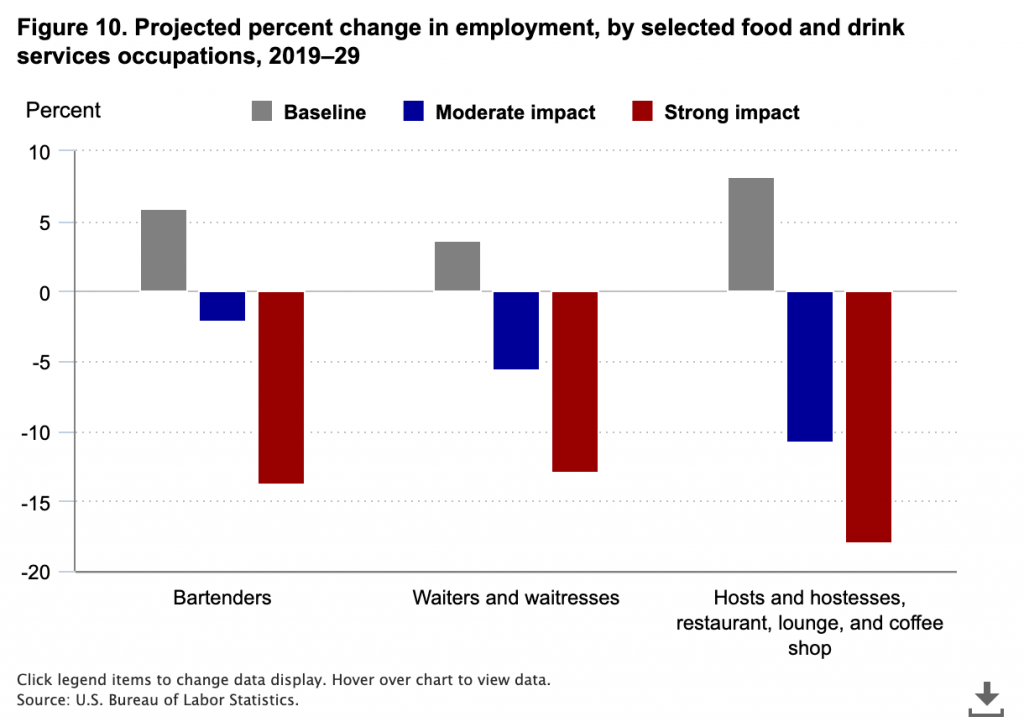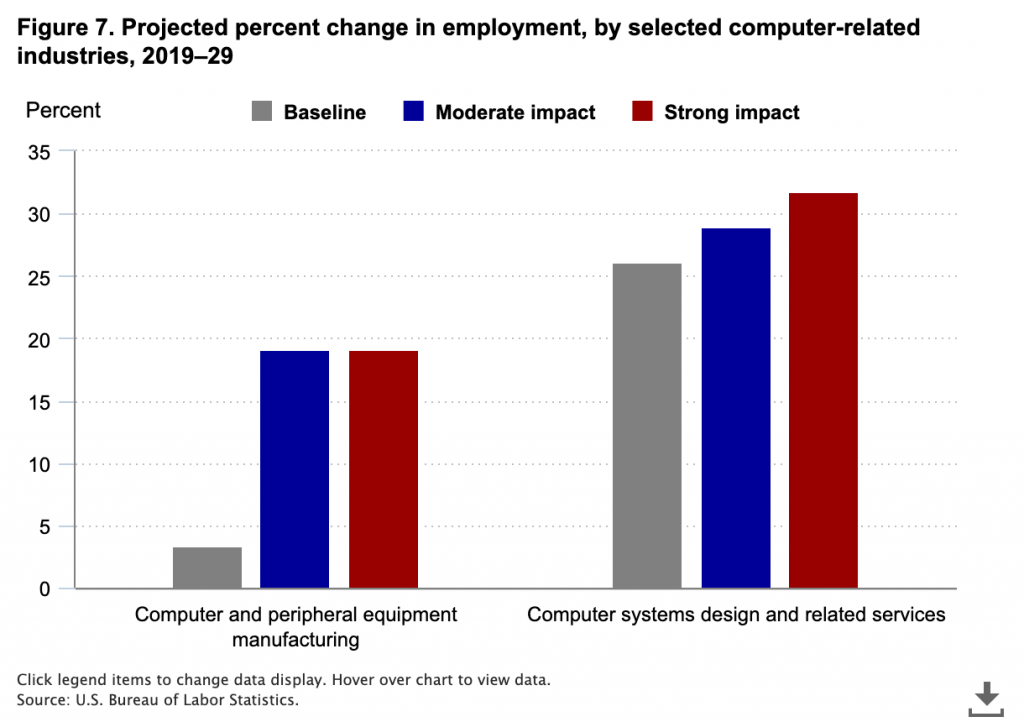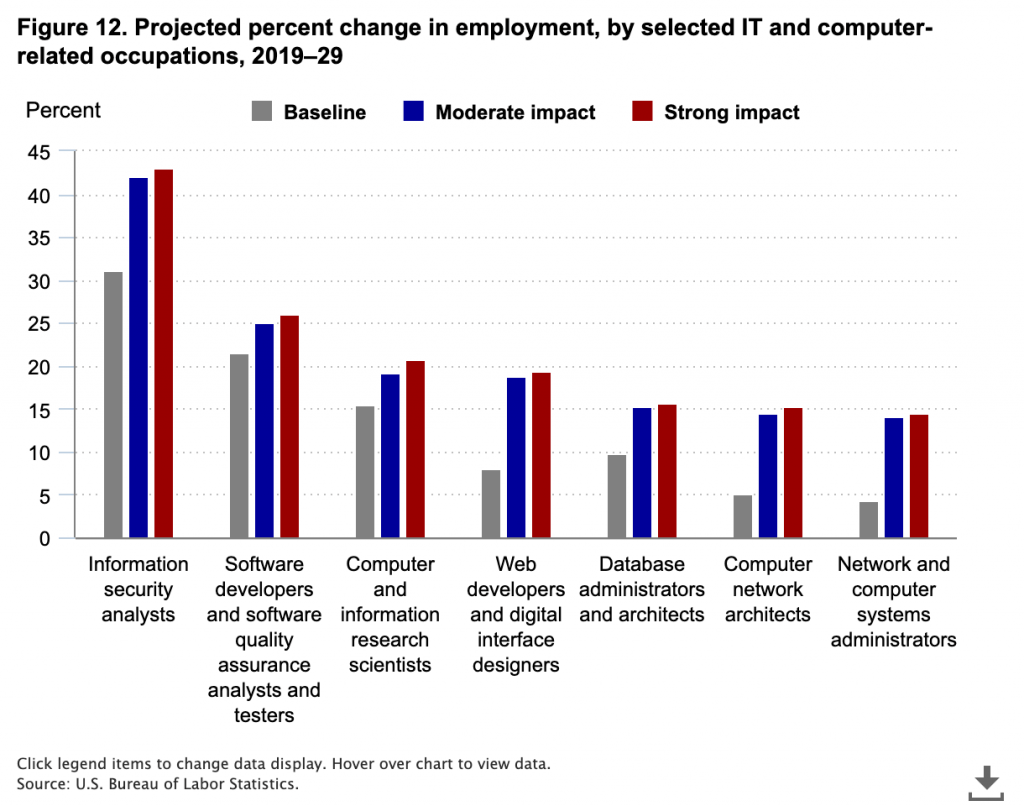When the US Bureau of Labor Statistics released its ten-year employment projections for 2020-2030 in September 2021, it did so without considering the economic effects of the worst public health crisis in a generation. The research had been completed; the projections foretold. But with COVID-19 affecting as many areas of the job market as it did, the Bureau decided to re-release its projection report in February 2021, this time factoring the pandemic into their prognosis. When the Bureau updated its report later on, it foretold a somber story for some industries and the beginning of a boom for others — thanks to COVID.
Great employment news for those who have some form of specialized training or higher education; not such great news for those with unskilled labor jobs. Even before COVID threw a monkey wrench into 2020’s plans, the US Bureau of Labor Statistics predicted that jobs in tech and healthcare would increase in the coming decade, while jobs that do not require any special education would decrease. The current healthcare crisis has only emphasized and accelerated these predictions.
COVID-BARRING STRUCTURAL CHANGES
Typically, the Bureau’s ten-year forecast, updated and released yearly, is representative of wider structural changes to our workforce, as opposed to more volatile short-term predictions that reflect current world events. Jobs in healthcare were predicted to increase even before the COVID crisis, due in large part to the aging baby boomer generation, longer life expectancies, and an increase in chronic illness diagnoses. Jobs in tech were expected to increase to keep pace with rapid technological advancements, the popularity of e-commerce, persistent automation efforts, and the emphasis on IT security and software development.
Adversely, the 2019-2029 change in the job market trends report indicated a pre-COVID decline in select unskilled jobs, such as cashier jobs. It reported this decline was due in part to increased online shopping, automated checkout, and contactless payment methods. The original job prognosis released in September 2020 favored jobs that require a specialized education, such as jobs in the healthcare and tech space, over unskilled jobs, such as waiters and cashiers. Hospitality jobs were predicted to fall in this new report, while one corner of the job market strengthened: tech jobs, specifically entry level tech jobs.
But what happens when you sprinkle COVID and its monumental effects on the economy and workforce into the pot? After having a chance to reflect on the economic effects of the pandemic, the Bureau amped up their report from seemingly average to a job projection report on steroids and unleashed it on the public.
JOB REPORT MAKEOVER
In February 2021, the US Bureau of Labor Statistics published an update to their 2019-2029 job projection that reflects how job market trends will change due to COVID. The pandemic turned the ten-year job report up to an eleven, meaning that many jobs predicted to be on the up-and-up are now expected to explode, while jobs slowly ambling down the hill are now falling off the cliff. This job report makeover reinforces and amplifies the predictions that were released in September 2020, and highlights which industries are set to gain and which industries are set to lose.
The Bureau’s February update included two new prediction classifications for job growth that reflect changes to industry due to COVID: Moderate Impact, meaning COVID has some shorter-term impact on this industry and the way it operates, and Strong Impact, meaning COVID will cause deeper structural changes to this industry. The Baseline segment is the pre-COVID report prediction.
THE BUREAU OF BAD NEWS
The updated report indicates that jobs in the transportation, hospitality, and brick–and–mortar retail spaces will decline at a faster rate than previously predicted in the next decade. Examples of these declining consumer-facing roles include cashiers, waiters, waitresses, hosts, hostesses, bartenders, bus drivers, hotel, motel, and resort desk clerks, receptionists, flight attendants, and travel clerks. Host and hostess job growth is expected to drop –10.8% in the Moderate Impact segment, and –18.0% in the Strong Impact segment.

Bear in mind, job market trends are capricious and ever-changing, meaning that these predictions are not definite and are subject to change. It’s too soon to tell if these jobs are projected to decline because of current social distancing protocols and limited business capacities, or if they reflect a seismic shift in consumer behavior. How have we, as consumers, adapted to new forms of shopping, traveling, and dining, and what’s the staying power of this change? Though we may not be sure how greatly hospitality and retail will be affected, the report made clear that some industries are sure-footed, both before COVID and as a result of COVID.
A RISE IN TECH JOBS
The Bureau of Labor Statistics announced good news to those hoping to work in the tech and healthcare industries. Specifically for tech, the Bureau estimated that the influx of employees working from home will demand more IT support, both from a network standpoint and a security standpoint. The preliminary employment prediction report estimated a 26.1% growth for computer systems design and related services jobs. This industry growth was projected to be much higher than the average growth for all industries, which was only 3.7%.
The updated report released in February showed even more promise for tech jobs in both the Moderate Impact and Strong Impact segments. The Moderate Impact scenario numbers predict a 29% increase in computer systems design and related services jobs, while the Strong Impact scenario numbers predict a 31.8% increase.

Other IT and computer-related occupations are expected to rise as well. Information security analysts show the strongest growth percentages all three categories, with the Baseline growth rate predicted to be 31.2%, the Moderate Impact growth rate at 42.1%, and the Strong Impact growth rate at 43%. These numbers are astronomical compared to other industries.
Software developers, computer and information research, web developers, and network systems administrators showed strong job growth rate predictions as well. As the popularity and prevalence of teleworking and e-commerce continue to rise in this country, so will the need for strong technical talent. IT professionals went into overdrive to ensure sensitive company data was protected. They made sure their employees were secure, connected to the network, and well-settled into a work-from-home life. Now, as more companies realize they can reduce overhead costs and increase employee satisfaction by allowing employees to work from home and as employees transition to a more regular work-from-home or hybrid schedule, IT professionals and their skills are only becoming more apparent.
Pre-COVID days predicted a steady rise in these job opportunities, but the COVID crisis shone a spotlight on how badly we need these roles in our modern marketplace.

how can i get into it?
The industry needs fresh tech talent — and this will be the case in the coming decade and beyond. With the rise of automation, ecommerce, telework, and telehealth, tech opportunities are continuing to grow. Luckily, you can get your start in IT in only 4 months — no prior IT experience required. Centriq’s IT Career Training Program offers two tracks (Systems and Security Administration or Full Stack Web Developer) to get you on the road to a new career. Talk to us today to find out how to get started.
Sources:
US Bureau of Labor Statistics Monthly Labor Reviews – February 2021
US Bureau of Labor Statistics Employment Projections: 2020-2030 Summary
Oops! We could not locate your form.

